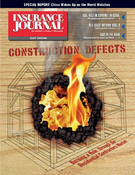With about two-thirds of the United States facing what some experts describe as a medical malpractice crisis, a pair of studies show how liability concerns could be hurting patient care and also limiting patients’ ability to be fairly compensated for their pain and suffering.
The studies were reported in the July/August issue of the journal Health Affairs.
One study from the Harvard School of Public Health, authored by David Studdert, associate professor of health policy and law; Michelle Mello, assistant professor of health policy and law; and Y. Tony Yang, found that imposing a cap on non-economic damages results in inequitable payouts across different types of injuries.
The authors analyzed a sample of jury verdicts in California that were subjected to the state’s $250,000 cap on non-economic damages. They found that reductions imposed on grave injuries were seven times larger than those for minor injuries. People suffering from pain and disfigurement had particularly large reductions in their awards.
Currently, 21 states cap damages for non-economic losses in med-mal cases.
“A flat dollar cap is unfair,” Studdert said. “When you look at the verdicts that are affected by caps, what you see is a really large number of cases that involve major injury.”
If policymakers pursue caps as a way to limit malpractice awards, Studdert said, “they ought to try to be more creative about the kinds of caps that they are enacting.”
The authors recommend that a schedule or sliding scale for non-economic damages would be more equitable.
“Under this approach, the maximum award in each severity bracket would be capped but at a level more commensurate with the severity of injury than a flat cap permits,” the study said, adding that it allows such awards to vary by severity of injury and also by the plaintiff’s age.
The other study, funded by the Pew Charitable Trusts Project on Medical Liability in Pennsylvania, found widespread discontent among physicians in that state, where several insurers have exited the market and malpractice premiums have increased dramatically.
Nearly 40 percent of the 824 Pennsylvania specialists surveyed in 2003 said that they were dissatisfied with the practice of medicine. The rate of dissatisfaction was twice as high as the rates in other states from a similar study conducted in 1999 and 2001.
Study authors, from HSPH, Columbia Law School, and Harris Interactive, note that a growing body of research has identified links between physician satisfaction and high-quality care. For example, studies have shown that patients of physicians with higher levels of job satisfaction are more likely to adhere to medical treatments, and satisfied physicians tend to be more attentive to patients. Physicians who are dissatisfied are more likely to engage in riskier prescribing practices, disrupt continuity of care, and practice defensive medicine.
Most physicians surveyed denied that malpractice concerns made them less candid with patients but a “sizable minority” felt that they did. Physicians who had been dropped by an insurer, been sued in the past three years, or faced high premiums were much more likely to report this.
More than 90 percent of specialists also said the malpractice system limits their ability to provide the highest-quality care. Specialists practicing in high-risk counties and those with high insurance premiums were much more likely to perceive that it limits quality “a great deal.”
Topics Pennsylvania
Was this article valuable?
Here are more articles you may enjoy.


 Wall Street Pushes Back After Activists Escalate Protests
Wall Street Pushes Back After Activists Escalate Protests  What Happened to Reinsurance ‘Class of 2023’? Hard Market Defies Age-Old Patterns.
What Happened to Reinsurance ‘Class of 2023’? Hard Market Defies Age-Old Patterns.  Viewpoint: Deepfake Fraud Is On the Rise. Here’s How Insurers Can Respond
Viewpoint: Deepfake Fraud Is On the Rise. Here’s How Insurers Can Respond  Study Urges Rethinking of Disaster Management in Era of Compounding Events
Study Urges Rethinking of Disaster Management in Era of Compounding Events 


